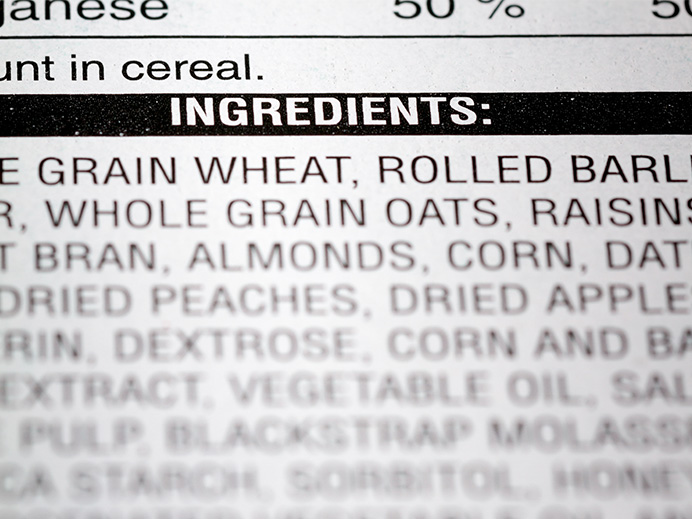Label Reading & the FDA
The only treatment for celiac disease is a strict gluten-free diet. This may seem challenging at first because many common foods contain gluten. However, there are many naturally gluten-free foods and gluten-free substitutes to choose from.

How to Tell if a Packaged Food Product is Gluten-Free
- A gluten-free label. If a product claims to be gluten-free on the package, then it is most likely safe to eat as the FDA only allows packaged foods with less than 20 parts per million (ppm) of gluten to be labeled “gluten-free.” However, you should still check the ingredients list. It is also important to remember that “wheat-free” does not necessarily mean “gluten-free.”
- Check the allergen listing. Some packaging has a list of common allergens found in the product. Such allergens include wheat, soy, egg, nuts, and milk. This list can be a quick way to rule something out if the package says: “contains wheat.” However, a lack of allergen labeling does NOT mean that the product is gluten-free. Barley and rye are not in the top eight allergens required to be listed. Be sure to check the ingredients list for other hidden sources of gluten.
- Check for obvious ingredients.
- Wheat
- Barley
- Rye
- Malt
- Brewer’s yeast
- Oats (unless specifically labeled gluten-free)
If there is not a “gluten-free” label on the product packaging, read the ingredients label thoroughly. Check for hidden or questionable ingredients. Some ingredients may contain gluten.
Fast Facts About the FDA Gluten-Free Food Labeling Rule
1. What food products are covered by the FDA gluten-free labeling rule?
Covered:
- All FDA-regulated foods
- Dietary supplements (vitamins, minerals, herbs, amino acids)
- Imported food products that are subject to FDA regulations
Not Covered:
- Meat, poultry, and unshelled eggs (and any other products regulated by the USDA)
- Distilled spirits and wines that contain 7% or more alcohol by volume
- Malted beverages made with malted barley or hops
2. What food products may be labeled gluten-free?
A food product regulated by the FDA may be labeled gluten-free if:
- It is inherently gluten-free, meaning it does NOT contain wheat, rye, barley, or their crossbred hybrids like triticale (a gluten-containing grain) OR
- It does NOT contain an ingredient that is derived from a gluten-containing grain that has not been processed to remove gluten (e.g., wheat flour) OR
- It does NOT contain an ingredient derived from a gluten-containing grain that has been processed to remove gluten (e.g., wheat starch), if the use of that ingredient results in the presence of 20 ppm or more gluten in the food
Also, any unavoidable presence of gluten in the food must be less than 20 ppm.
3. May food products that are naturally gluten-free be labeled gluten-free?
Yes. Food products that are naturally gluten-free, like bottled spring water or tomatoes, may be labeled gluten-free.
4. May oats be labeled gluten-free?
Oats that contain less than 20 ppm of gluten may be labeled gluten-free. Oats do not need to be certified gluten-free. Some people with celiac disease may have an immune reaction to the avenin in oats, a protein similar to gluten, even if labeled gluten-free. It is important to speak with your gastroenterologist or dietitian about whether you should include oats in your gluten-free diet.
5. Will there be a symbol to identify foods that meet the FDA definition of gluten-free?
No. The FDA has determined that consumers favor the label “gluten-free” to communicate that a food is free of gluten. Manufacturers are allowed to include a symbol as long as it is truthful and not misleading.
6. Are manufacturers required to test for gluten to label a product gluten-free?
No. Manufacturers are not required to test for the presence of gluten in ingredients or in the finished gluten-free-labeled food product. However, they are responsible for ensuring that the food product meets all labeling requirements. Manufacturers will need to determine how they will ensure this.
7. How will the FDA enforce gluten-free labeling requirements?
The FDA may perform food label reviews, follow-up on consumer and industry complaints, and analyze food samples. Consumers and manufacturers may report a complaint to an FDA Consumer Complaint Coordinator in the state where the food was purchased.
- Contact FDA’s Center for Food Safety and Applied Nutrition’s Adverse Event Reporting System called “CAERS” by phone, 240-402-2405 or email, [email protected]
- Consumers and manufacturers can also report any complaint they may have about an FDA-regulated food (e.g., potential misuse of gluten-free claims on food labels) to an FDA Consumer Complaint Coordinator for the state where the food was purchased. A list of FDA Consumer Complaint Coordinators is posted at FDA’s website. Reports should include:
- the name, addresses, and phone numbers of persons affected and the person reporting the incident.
- the doctor or hospital if emergency treatment was provided.
- a clear description of the problem. Describe the product as completely as possible, including any codes or identifying marks on the label or container.
- the name and address of the store where the product was purchased and the date of purchase.
8. Why did the FDA adopt <20 ppm of gluten as the standard instead of zero ppm? Why does the Celiac Disease Foundation support this?
The FDA used an analytical methods-based approach to define the term gluten-free and adopted <20 ppm gluten as one of the criteria for a food labeled gluten-free because the agency relies upon scientifically-validated methods for enforcing its regulations.
Analytical methods that are scientifically validated to reliably detect gluten at a level lower than 20 ppm are not currently available. In addition, some celiac disease researchers and some epidemiological evidence suggest that most individuals with celiac disease can tolerate variable trace amounts and concentrations of gluten in foods (including levels that are less than 20 ppm gluten) without causing adverse health effects.
The Celiac Disease Foundation Medical Advisory Board supports the <20 ppm of gluten standard for gluten-free labeling. According to Dr. Peter Green, Director of the Celiac Disease Center at Columbia University, “The 20 ppm is a scientifically determined level of gluten that has been shown to be tolerated by those with celiac disease. It is in line with standards in other countries.”
Dr. Alessio Fasano of the Center for Celiac Research states, “Twenty parts per million, or 20 parts of gluten per one million parts of food sample, is an accepted standard in many parts of the world for products that are labeled gluten-free. The evidence-based research published by our Center, which has been confirmed by studies from colleagues around the world, conclusively supports the 20 ppm level as a suitable safety threshold for gluten-free products.”
According to the Center’s website, “research from the Center has shown that 10 milligrams per day of gluten consumption is a safe level for the vast majority of individuals with celiac disease.” The Center’s website goes on to state that 10 milligrams is roughly the equivalent of one-eighth of a teaspoon of flour, or 18 slices of gluten-free bread with each slice containing 20 ppm of gluten.
9. Does the FDA gluten-free labeling rule apply to foods served in restaurants?
The gluten-free labeling rule applies to packaged foods, which may be sold in some retail and food-service establishments, such as some carry-out restaurants. However, given the public health significance of “gluten-free” labeling, the FDA says that restaurants making a gluten-free claim on their menus should be consistent with the FDA’s definition.

